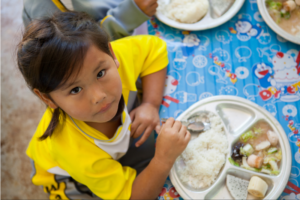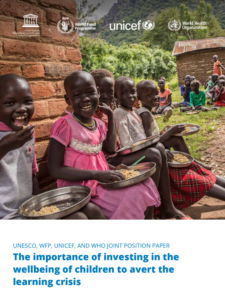Investing in school health and nutrition programmes to avert a learning crisis
In a recently published call to action, UNESCO, UNICEF, WHO and WFP urge national governments and partners to invest in school health and nutrition programmes to avert a learning crisis. This is more important than ever, as we witness the largest disruption of education systems…
In a recently published call to action, UNESCO, UNICEF, WHO and WFP urge national governments and partners to invest in school health and nutrition programmes to avert a learning crisis. This is more important than ever, as we witness the largest disruption of education systems in history: some 1.6 billion school-age children affected and 370 million children missing out on safe and nutritious school meals because of the global COVID-19 pandemic.
UNESCO, UNICEF, WFP and WHO call on all national governments and development partners to advance an equitable, inclusive and progressive approach to education that includes comprehensive, integrated school health and nutrition programmes strengthening school policies, outreach, curricula, environment and school health services throughout primary and secondary education, so as to ensure that all children and young people have the required conditions to learn and thrive and contribute meaningfully to the development of sustainable and healthy future of their communities and countries. This is in line with the principles of the right to education and the right to health.
The four agencies stand ready to align efforts and to work with partners to ensure that this important issue is reflected in national, regional and global agendas, and that funding is mobilized to support the scale up of national schoolbased education and health and nutrition programmes.
Improved school health and nutrition programmes have tremendous impact in fostering equity in and through schools, with the benefits most apparent for girls, and children at risk of being excluded from learning: the poor, the sick, those who are suffering from all forms of malnutrition, those who are pregnant or parenting, and those with disabilities.
Providing health and nutrition interventions through schools means accessing the millions of children and adolescents and preparing them with knowledge and skills for healthy behaviours throughout their life. It also attracts out-of-school children, leveraging global efforts to enhance the quality and inclusiveness of education, including in emergency contexts.
Providing school meals and health services at school can reduce the sense of marginalization and contribute to building social cohesion and peace. For children living in fragile and conflict-affected areas and refugee settings, school health and nutrition programmes can become an essential safeguard by contributing to a sense of normalcy and educational continuation.
The gains are particularly promising for girls, as some of the most common health conditions affecting education are more prevalent in girls. They experience higher rates of anaemia than boys, they may miss school due to menstruation and limited menstrual health and hygiene management (MHHM) opportunities, and gender inequalities can place them at greater risk of violence, ill health and malnutrition. In addition to the important impact of school health and nutrition services in fostering equity, adequate and relevant health and nutrition education also plays a key role in promoting equality and inclusion, and challenging health related stigma and discrimination.
The importance of investing in the wellbeing
of children to avert the learning crisis

